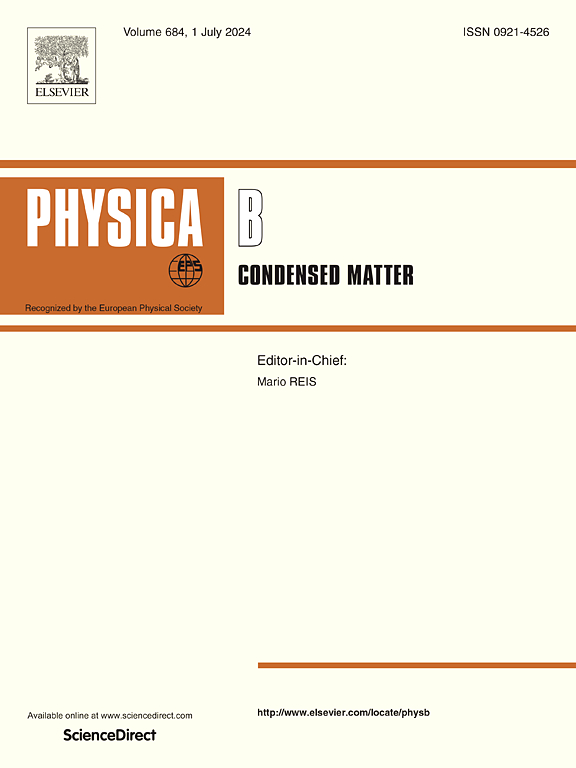寄生吸收氧化锌作为透明导电氧化层用于硅异质结太阳能电池
IF 2.8
3区 物理与天体物理
Q2 PHYSICS, CONDENSED MATTER
引用次数: 0
摘要
ZnO具有成本低、导电性好、透光性好等优点,是硅异质结(HJT)太阳能电池透明导电氧化物(TCO)的理想材料。然而,它会导致紫外线(UV)波段的强寄生吸收。有效利用紫外光在ZnO中诱导的光生载流子,有望提高HJT太阳能电池的紫外光转换电位,提高电池的功率转换效率(PCE)。本文利用Silvaco软件对ZnO/a-Si(n)/a-Si(i)/c-Si(p)/a-Si(i)/a-Si(p)太阳能电池进行了数值和理论研究。通过改变ZnO薄膜的关键参数,可以改变HJT太阳能电池的性能,并研究了影响ZnO载流子利用率的因素。发现ZnO中的光生载流子可以被利用。然而,ZnO/a-Si异质结的势垒影响了ZnO中光生空穴的扩散。增加给体浓度和降低ZnO的电子亲和能降低该势垒,导致紫外波段外量子效率和短路电流的增加。此外,虽然较厚的ZnO层增强了紫外吸收,但它促进了光生成孔向Si的扩散,而Si对势垒的宽度更敏感。本研究为降低ZnO作为TCO层的寄生紫外吸收提供了理论参考,对提高HJT电池的UV PCE,降低生产成本具有重要意义。本文章由计算机程序翻译,如有差异,请以英文原文为准。
Parasitic absorption of zinc oxide as a transparent conductive oxide layer for silicon heterojunction solar cells
ZnO, due to its low cost, good electrical conductivity, and excellent light transmittance, is ideal for use as the transparent conductive oxide (TCO) layer of Si heterojunctions with intrinsic thin-layer (HJT) solar cells. However, it leads to a strong parasitic absorption in the ultraviolet (UV) band. Effectively utilizing the photogenerated carriers induced by UV light in ZnO is expected to enhance the UV photon conversion potential and improve the power conversion efficiency (PCE) of HJT solar cells. Here, the Silvaco software was used to numerically and theoretically investigate ZnO/a-Si(n)/a-Si(i)/c-Si(p)/a-Si(i)/a-Si(p) solar cells. By varying key parameters of the ZnO film, the performance of the HJT solar cells could be changed, and the factors affecting the utilization of the carriers generated in ZnO were investigated. It was found that the photogenerated carriers in ZnO can be utilized. Nevertheless, the diffusion of the photogenerated holes in ZnO is affected by the potential barrier at the ZnO/a-Si heterojunction. Increasing the donor concentration and decreasing the electron affinity of ZnO reduce this barrier, leading to an increase in the external quantum efficiency in the UV band and short-circuit current. Furthermore, although a thicker ZnO layer results in enhanced UV absorption, it promotes the diffusion of the photogenerated holes into Si, which is more sensitive to the width of the barrier. This study provides theoretical reference for reducing the parasitic UV absorption of ZnO as a TCO layer, which is of significance for enhancing the UV PCE of HJT cells and reducing production costs.
求助全文
通过发布文献求助,成功后即可免费获取论文全文。
去求助
来源期刊

Physica B-condensed Matter
物理-物理:凝聚态物理
CiteScore
4.90
自引率
7.10%
发文量
703
审稿时长
44 days
期刊介绍:
Physica B: Condensed Matter comprises all condensed matter and material physics that involve theoretical, computational and experimental work.
Papers should contain further developments and a proper discussion on the physics of experimental or theoretical results in one of the following areas:
-Magnetism
-Materials physics
-Nanostructures and nanomaterials
-Optics and optical materials
-Quantum materials
-Semiconductors
-Strongly correlated systems
-Superconductivity
-Surfaces and interfaces
 求助内容:
求助内容: 应助结果提醒方式:
应助结果提醒方式:


